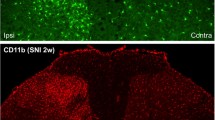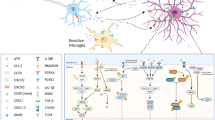Abstract
Recent experimental results have demonstrated a glial activation during long-term pain that produces and releases cytokines, free oxygen radicals, nitric oxide, and other neuroactive substances in the spinal cord dorsal horns. Such activation might generate a vicious circle by increasing the neuronal excitability level due to a decreased astroglial glutamate uptake and thereby reinforce pain signals that travel up to the thalamus and further up into the parietal cortex for identification and interpretation. In this paper, we adapt new knowledge on neuronal-glial signaling in the CNS to develop tentative explanations at the cellular level for the maintenance of pain signals in the brain, for formation of “pain memory,” and even for the increased pain sensitivity that persons with chronic pain often experience in body regions other than those originally affected. We also suggest a hypothetical mechanism at the cellular level underlying the mental fatigue from which persons with chronic pain may suffer. This hypothesis relies on the impaired astroglial glutamate uptake capacity due to the production of neuroactive substances, altered conditions in the chronic pain state, and the anxiety and stress reactions that may occur secondary to the pain. Neuronal activity over time in the dysfunctional state of the astroglial network leads to an increase in extracellular glutamate levels in the vicinity of glutamate synapses. In turn, this increase leads over time to less precision in glutamate transmission. The increased extracellular glutamate levels lead to increased excitability and increased energy requirements. When cellular energy decreases the glutamate transmission decreases, and according to our hypothesis, this is one cause of mental fatigue. New strategies for treatment of chronic pain and the associated mental fatigue are formulated and should be explored.
Similar content being viewed by others
references
Watkins, L. R. and Maier, S. F. 2002. Beyond neurons: Evidence that immune and glial cells contribute to pathological pain states. Physiol. Rev. 82:981–1011.
Nitu, A. N., Wallihan, R., Skljarevski, V., and Ramadan, N. M. 2003. Emerging trends in the pharmacotherapy of chronic pain. Expert Opin. Investig. Drugs 12:545–559.
Varney, M. A. and Gereau, R. W. 4th 2002. Metabotropic glutamate receptor involvement in models of acute and persistent pain: prospects for the development of novel analgesics. Curr. Drug Target CNS Neurol. Disord. 1:283–296.
Watkins, L. R., Milligan, E. D., and Maier, S. F. 2001. Spinal cord glia: new players in pain. Pain 93:201–205.
Rutkowski, M. D. and DeLeo, J. A. 2002. The role of cytokines in the initiation and maintenance of chronic pain. Drug News Perspect. 15:626–632.
DeLeo, J. A. and Colburn, R. W. 1999. Proinflammatory cytokines and glial cells: their role in neuropathic pain. Pages 159–182, in Watkins, L. (ed.), Cytokines and pain. Birkhauser, Basel.
Meller, S. T. Dykstra, C., Grzbycki, D., Murphy, S., and Gebhart, G. F. 1994. The possible role of glia in nociceptive processing and hyperalgesia in the spinal cord of the rat. Neuropharmacology 33:1471–1478.
Hatten, M. E. and Mason, C. A. 1990. Mechanisms of glial-guided neuronal migration in vitro and in vivo. Experientia 46:907–916.
Ullian, E. M., Sapperstein, S. K., Christopherson, K. S., and Barres, B. A. 2001. Control synapse number by glia. Science 291:657–661.
Walz, W. 1989. Role of glial cells in regulation of the brain ion microenvironment. Progr. Neurobiol. 33:309–333.
Hansson, E., Olsson, T., and Rönnbäck, L. (eds.). 1997. On astrocytes and glutamate neurotransmission. Landes Bioscience Company, Springer Verlag, Austin, TX, Heidelberg, Germany.
Araque, A., Parpura, V., Sanzgiri, R. P., and Haydon, P. G. 1999. Tripartite synapses: glia, the acknowledged partner. Trends Neurosci. 22:208–215.
Hansson, E. and Rönnbäck, L. 2004. Astrocytic receptors and second messenger systems. Hertz, L. (ed.), in Advances in Molecular and Cell Biology. 31: 475–501.
Pasti, L., Volterra, A., Pozzan, T., and Carmignoto, G. 1997. Intracellular calcium oscillations in astrocytes: a highly plastic, bidirectional form of communication between neurons and astrocytes in situ. J. Neurosci. 17:7817–7830.
Blomstrand, F., Khatibi, S., Muyderman, H., Hansson, E., Olsson, T., and Rönnbäck, L. 1999. 5-Hydroxytryptamine and glutamate modulate velocity and extent of intercellular calcium signalling in hippocampal astroglial cells in primary cultures. Neuroscience 88:1241–1253.
Sneyd, J., Charles, A. C., and Sanderson, M. J. 1994. A model for the propagation of intercellular calcium waves. Am. J. Physiol. 266:C293–C302.
Cotrina, M. L., Lin, J. H., Alves-Rodrigues, A., Liu, S., Li, J., Azmi-Ghadimi, H., Kang, J., Naus, C. C., and Nedergaard, M. 1998. Connexins regulate calcium signaling by controlling ATP release. Proc. Natl. Acad. Sci. USA 95:15735–15740.
Bezzi, P., Carmignoto, G., Pasti, L., Vesce, S., Rossi, D., Rizzini, B. L., Pozzan, T., and Volterra, A. 1998. Prostaglandins stimulate calcium-dependent glutamate release in astrocytes. Nature 391:281–285.
Muyderman, H., Ängehagen, M., Sandberg, M., Björklund, U., Olsson, T., Hansson, E., and Nilsson, M. 2001. α1-Adrenergic modulation of metabotropic glutamate receptor-induced calcium oscillations and glutamate release. J. Biol. Chem. 49:46504–46514.
Kreutzberg, G. W. 1996. Microglia: a sensor for pathological events in the CNS. Trends Neurosci. 19:312–318.
Kaur, C., Hao, A. J., Wu, C. H., and Ling, E. A. 2001. Origin of microglia. Microscop. Res. Tech. 54:2–9.
Hansson, E. and Rönnbäck, L. 2003. Glial neuronal signaling in the central nervous system. FASEB J. 17:341–348.
Watkins, L. R., Martin, D., Ulrich, P., Tracey, K. J., and Maier, S. F. 1997. Evidence for the involvement of spinal cord glia in subcutaneous formalin induced hyperalgesia in the rat. Pain 71:225–235.
Covey, W. C., Ignatowski, T. A., Renauld, A. E., Knight, P. R., Nader, N. D., and Spengler, R. N. 2002. Expression of neuron-associated tumor necrosis factor alpha in the brain is increased during persistent pain. Reg. Anesth. Pain Med. 27:357–366.
Fine, S. M., Angel, R. A., Perry, S. W., Epstein, L. G., Rothstein, J. D., Dewhurst, S., and Gelbard, H. A. 1996. Tumor necrosis factor alpha inhibits glutamate uptake by primary human astrocytes. Implications for pathogenesis of HIV-1 dementia. J. Biol. Chem. 271:15303–15306.
McNaught, K. S. and Jenner, P. 2000. Extracellular accumulation of nitric oxide, hydrogen peroxide, and glutamate in astrocytic cultures following glutathione depletion, complex I inhibition, and/or lipopolysaccharide-induced activation. Biochem. Pharmacol. 60:979–988.
Watkins, L. R., Milligan, E. D., and Maier, S. F. 2001. Glial activation: a driving force for pathological pain. Trends Neurosci. 24:450–455.
Riedel, G. 1996. Function of metabotropic glutamate receptors in learning and memory. Trends Neurosci. 19:219–224.
Yudkoff, M., Nissim, I., Daikhin, Y., Lin, Z-P., Nelson, D., Pleasure, D., and Erecinska, M. 1993. Brain glutamate metabolism: neuronal-astroglial relationships. Dev. Neurosci. 15:343–350.
Hansson, E. and Rönnbäck, L. 1995. Astrocytes in glutamate neurotransmission. FASEB J. 9:343–350.
Haydon, P. G. 2001. Glia: listening and talking to the synapse. Nature Neurosci. Rev. 2:185–193.
Sims, K. D. and Robinson, M. B. 1999. Expression patterns and regulation of glutamate transporters in the developing and adult nervous system. Crit. Rev. Neurobiol. 13:169–197.
Barres, B. A. 1991. New roles for glia. J. Neurosci. 11:3685–3694.
Ozog, M. A., Siushansian, R., and Naus, C. C. 2002. Blocked gap junction coupling increases glutamate-induced neurotoxicity in neuron-astrocyte co-cultures. J. Neuropathol. Exp. 61:132–141.
Rothstein, J. D., Dykes-Hoberg, M., Pardo, C. A., Bristol, L. A., Jin, L., Kuncl, R., Kanai, Y., Hediger, M. A., Wang, Y., Schielke, J. P., and Welty, D. F. 1996. Knockout of glutamate transporters reveals a major role of astroglial transport in excitotoxicity and clearance of glutamate. Neuron 16:675–686.
Erecinska, M., and Silver, I. A. 1990. Metabolism and role of glutamate in mammalian brain. Prog. Neurobiol. 35:245–296.
Hertz, L. 1979. Functional interactions between neurons and astrocytes. I. Turnover and metabolism of putative amino acid transmitters. Prog. Neurobiol. 13:277–323.
Schousboe, A. 1981. Transport and metabolism of glutamate and GABA in neurons and glial cells. Int. Rev. Neurobiol. 22:1–45.
Danbolt, N. C. 2001. Glutamate uptake. Prog. Neurobiol. 65:1–105.
Chizh, B. A. 2002. Novel approaches to targeting glutamate receptors for the treatment of chronic pain: review article. Amino Acids 23:169–176.
Tzschentke, T. M. 2002. Glutamatergic mechanisms in different disease states: overview and therapeutical implications—an introduction. Amino Acids 23:147–152.
Anderson, J. M., Kaplan, M. S., and Felsenthal, G. 1990. Brain injury obscured by chronic pain: a preliminary report. Arch. Phys. Med. Rehabil. 71:703–708.
Åström, M., Adolfsson, R., Asplund, K., and Åström, T. 1992. Life before and after stroke. Cerebrovasc. Dis. 2:28–34.
Schalén, W., Hansson, L., Nordström, G., and Nordström, C-H. 1994. Psychosocial outcome 5-8 years after severe traumatic brain lesions and the impact of rehabilitation services. Brain Injury 8:49–64.
Colosimo, C., Millefiorini, E., Grasso, M. G., Vinci, F., Fiorelli, M., Koudriavtseva, T., Pozzilli, C. 1995. Fatigue in MS is associated with specific clinical features. Acta Neurol. Scand. 92:353–355.
Bohnen, N. L., Jolles, J., Twijnstra, A., Mellink, R., and Wijnen, G. 1995. Late neurobehavioral symptoms after mild head injury. Brain Injury 9:27–33.
McFarlane, A. C., Weber, D. L., and Clark, C. R. 1993. Abnormal stimulus processing in posttraumatic stress disorder. Biol. Psychiatry 34:311–320.
Lindqvist, G. and Malmgren, H. 1993. Organic mental disorders as hypothetical pathogenetic processes. Acta Psychiatr. Scand. (Suppl) 373:5–17.
Banati, R. B. 2002. Brain plasticity and microglia: is transsynaptic glial activation in the thalamus after limb denervation linked to cortical plasticity and central sensitisation? J. Physiol. (Paris) 96:289–299.
Tsigos, C. and Chrousos, G. P. 2002. Hypothalamic-pituitary-adrenal axis, neuroendocrine factors and stress. J. Psychosom. Res. 53:865–871.
Virgin, C. E., Jr., Ha, T. P., Packan, D. R., Tombaugh, G. C., Yang, S. H., Horner, H. C., and Sapolsky, R. M. 1991. Glucocorticoids inhibit glucose transport and glutamate uptake in hippocampal astrocytes: implications for glucocorticoid neurotoxicity. J. Neurochem. 57:1422–1428.
Barbour, B., Szatkowski, M., Ingledew, N., and Attwell, D. 1989. Arachidonic acid induces a prolonged inhibition of glutamate uptake into glial cells. Nature 342:918–919.
Leonova, J., Thorlin, T., Åberg, N. D., Eriksson, P. S., Rönnbäck, L., and Hansson, E. 2001. Endothelin-1 decreases glutamate uptake in primary cultured rat astrocytes. Am. J. Physiol. Cell. Physiol. 281:C1495–C1503.
Swanson, R. A., Farrell, K., and Simon, R. P. 1995. Acidosis causes failure of astrocyte glutamate uptake during hypoxia. J. Cereb. Blood Flow Metab. 15:417–424.
Ye, Z. C. and Sontheimer, H. 1996. Cytokine modulation of glial glutamate uptake: a possible involvement of nitric oxide. Neuroreport 7:2181–2185.
Åberg, N. D., Blomstrand, F., Åberg, M. A. I., Björklund, U., Carlsson, B., Carlsson-Skwirut, C., Bang, P., Rönnbäck, L., and Eriksson, P. S. 2003. Insulin-like growth factor I increases astrocyte intercellular gap junctional communication and connexin 43 expression in vitro. J. Neurosci. Res. 74:12–22.
Dinkel, K., MacPherson, A., and Sapolsky, R. M. 2003. Novel glucocorticoid effects on acute inflammation in the CNS. J. Neurochem. 84:705–716.
John, G. R., Scemes, E., Suadicani, S. O., Liu, J. S. H., Charles, P. C., Lee, S. C., Spray, D. C., and Brosnan, C. F. 1999. IL-1β differentially regulates calcium wave propagation between primary human fetal astrocytes via pathways involving P2 receptors and gap junction channels. Proc. Natl. Acad. Sci. USA 96:11613–11618.
Sweitzer, S. M., Schubert, P., and DeLeo, J. A. 2001. Propentofylline, a glial modulating agent exhibits anti-allodynic properties in a rat model of neuropathic pain. J. Pharmacol. Exp. Ther. 297:1210–1217.
Hirsch, E. C., Breidert, T., Rousselet, E., Hunot, S., Hartmann, A., and Michel, P. P. 2003. The role of glial reaction and inflammation in Parkinson's disease. Ann. NY Acad. Sci. 991:214–228.
Author information
Authors and Affiliations
Corresponding author
Rights and permissions
About this article
Cite this article
Hansson, E., Rönnbäck, L. Altered Neuronal–Glial Signaling in Glutamatergic Transmission as a Unifying Mechanism in Chronic Pain and Mental Fatigue. Neurochem Res 29, 989–996 (2004). https://doi.org/10.1023/B:NERE.0000021243.86287.43
Issue Date:
DOI: https://doi.org/10.1023/B:NERE.0000021243.86287.43




